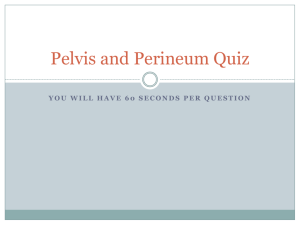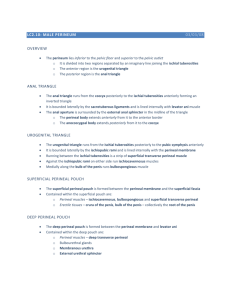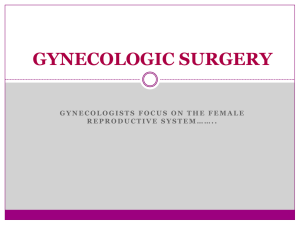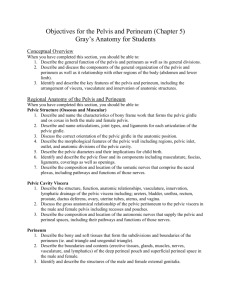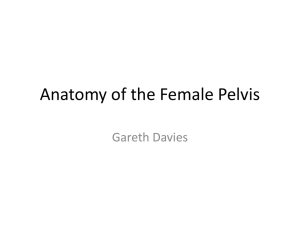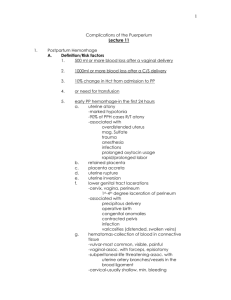Posterior or anal triangle
advertisement
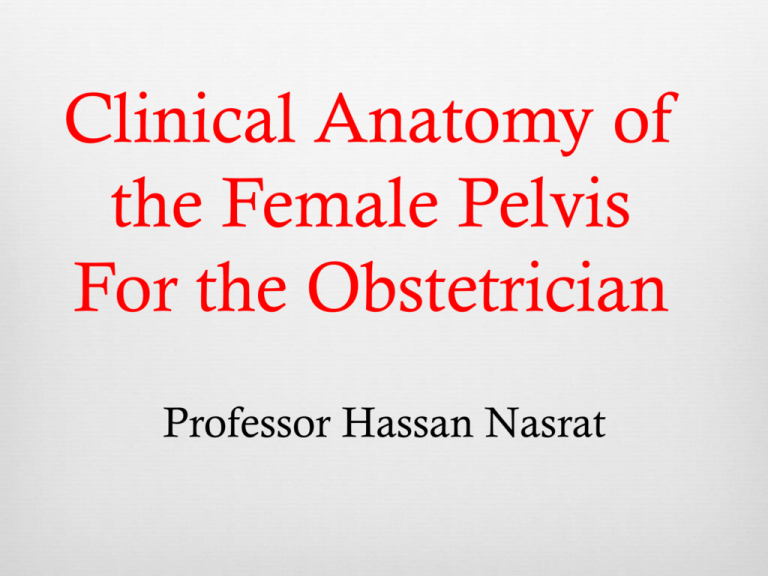
Clinical Anatomy of the Female Pelvis For the Obstetrician Professor Hassan Nasrat The Bony Pelvis The ileopectineal line divides the pelvis into the false and the true pelvis The normal female pelvis is described as “gynecoid” to be differentiated from the male “android pelvis”. The pelvic inlet “pelvic brim” 13 cm 12 cm Antero-posterior Transverse Engagement of the fetal head usually occurs through the transverse diameter The Pelvic Cavity The pelvic cavity: Is the curved canal between inlet and outlet. In the normal female pelvis the cavity is circular in shape and curves forwards. All its diameters measureapproximate ly 12 cm. The Pelvic Outlet the two pubic bones make the pubic arch, which in the normal female pelvis forms an angle not less than 90°. A narrow angle will force the fetal head at delivery posteriorly and thus increase the risk of perineal tear Pelvic ligaments and Diaphragm The pudendal neurovascular bundle exits out of the greater sciatic foramen and reenters the pelvis through the lesser sciatic foramen. This is the site for administration of pudenal block for local anesthesia. The two main muscles: The levator ani muscle group: Pubococcygeus, puborectalis, and iliococcygeus. They muscles extend from the lateral pelvic walls downward and medially to fuse with each other posteriorly. The levator hiatus lies anteriorly and accommodates the urethra, vagina, and anus. The coccygeus muscles A triangular muscle arises from the ischial spine and inserts onto the sacrum and coccyx The Perineum The Perineum The perineum is divided into two parts (or triangles): Subdivided into: Anterior or urogenital triangle: A superficial and deep perineal spaces by a fibromuscular septum called the urogenital diaphragm Posterior or anal triangle: The midline attachment forms the fibromuscular perineal body. between the anal canal and the vagina The Superficial Perineal Space Boundaries of the Superficial Perineal Space Note that the superfial muscles of the urogenital triangle and the muscles of the anal triangle all converge in the midline at the central tendon of perineum (perineal body) . During episiotomy :It is important to recognize superficial transverse perineilmuscle in order to ensure proper cooptation. Is bounded by three sets of muscles: •The ischiocavernosus: •The bulbocavernosus (the sphincter of the Vagina): •The superficial transverse perinei: It also includes the Bartholin’s glands and the vestibular bulbs. The superfial muscles of the urogenital triangle and the muscles of the anal triangle all converge in the midline. The Deep Perineal Space The Anal Triangle The anal triangle is the area of the perineum behind an imaginary line that extends between the ischial tuberosities. The ischiorectal fossae : •A potential space that allows distention of the rectum during defecation and the vaginal wall during second stage of labor. •It is also a potential space for huge (up to one liter) hematoma collection and abscess formation. •The obturator nerve and internal pudendal vessels: run alongside the lateral wall of the ischiorectal fossa in the pudendal or Alcock’s canal. This canal is formed from the splitting of the fascia on the lateral wall of the ischiorectal fossa together with the obturator fascia itself. The external anal sphincter: The voluntary muscle which is responsible for fecal continence is located within the anal triangle. Its total length is about 2 cm, and it is composed Tear of external anal sphincter is not uncommon during delivery particularly operative one and should be carefully repaired. Failure to recognize tears of the external sphincter or inappropriate repair can precipitate anal incontinence. Nerve Supply of the Perineum Ilioinguinal nerve (L1) and genitofemoral nerve (L1, 2) The Pudendal nerve (S2-4) Perineal branch of posterior femoral cutaneous nerve Coccygeal and last sacral nerves (S4, 5) The Uterus In 75% the uterus is in the anteverted, anteflexed position. On rare occasion a retro-verted gravid uterus may get entrapped within the pelvis and beneath the sacral promontory, giving rise to anterior sacculatoin of the uterus. Clinically this presents with acute retention of urine. The Isthmus is the short constricted area that marks the junction of the uterine body with the cervix. The body of the uterus: It has three layers: The endometrium, the myometrium and the perimetrium: The myometrium: Has longitudinal, circular and oblique muscle fibers and is very expansile. The oblique muscle fibers run “criss-cross” and compress the blood vessels when the uterus is well contracted. It is found mostly in the upper segment of the uterus, where the placenta normally embeds. The richness in muscle fibers and its criss-cross important to ensure proper hemostasis following placental delivery. In contrast to that is the lower uterine segment which is poor hemostasis following placental delivery. This explains why bleeding in the third stage is more difficult to control if the placenta is implanted in the lower uterine segment as in cases of placenta praevia. The Endometrium: During pregnancy and childbirth, the endometrium is referred to as the decidua. The perimetrium: Is a layer of peritoneum that covers the uterus except at the sides where It extends to form the broad ligaments. Significant bleeding and hematoma can extend whithin the layers of the broad ligament into the extra peritoneal space with serious consequences The Cervix: Consists predominantly of collagenous connective tissue and mucopolysaccaride ground substance. It communicates with the uterine cavity through the internal os and with the vaginal canal through the external os. The endocervical canal is about 2.5 to 3 cm in length. It is lined by a single layer of specialized columnar epithelium and secretes mucus to facilitate sperm transport. During pregnancy the glands secretion forms a plug of mucus which helps protect against infection. This plug of mucous comes away stained with some blood just before labor commences. Many women refer to this as the “show”. Vascular Supply of the pelvis Note the anastomsis between the ovarian and uterine artery. Therefore the uterus receive blood supply from two sources on each side Note the Ureter Crosses below the Uterine Artery about 1 cm from the cervix Vessels and nerves of the deep perineal space Innervations of the Pelvis Routes of Nerve Supply to the uterus (visceral nerves). Pain of uterine contractions in the first stages is felt in the abdomen, lower back Routes of Nerve Supply to cervix and upper vagina (Somatic nerves) In the second stage additional source of pain from cervical stretching and perineal pressure.
